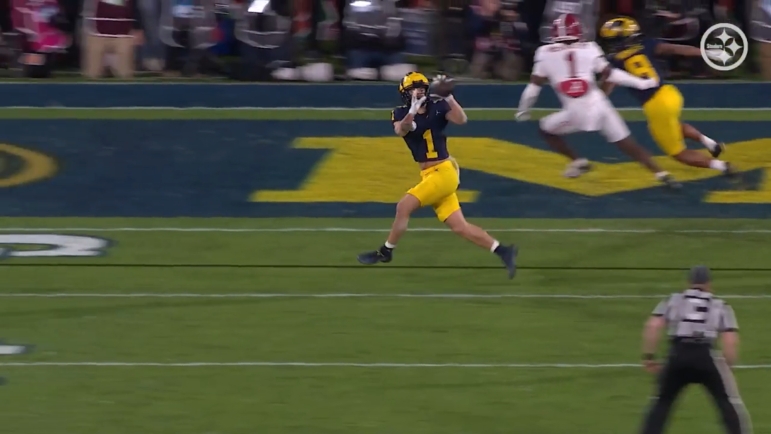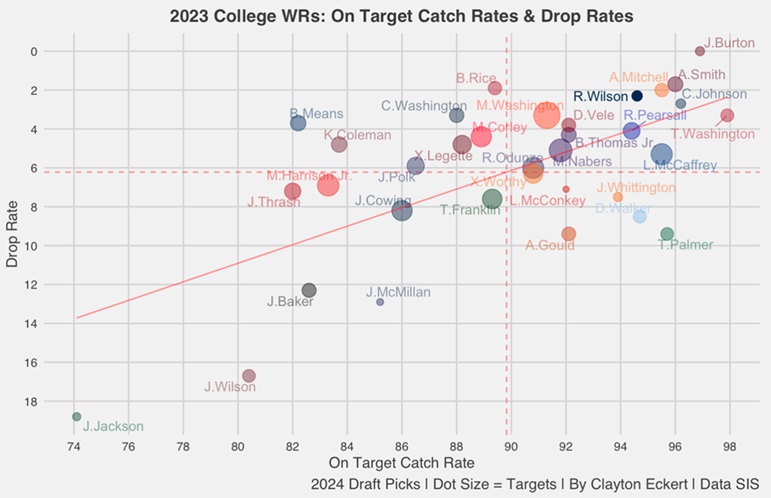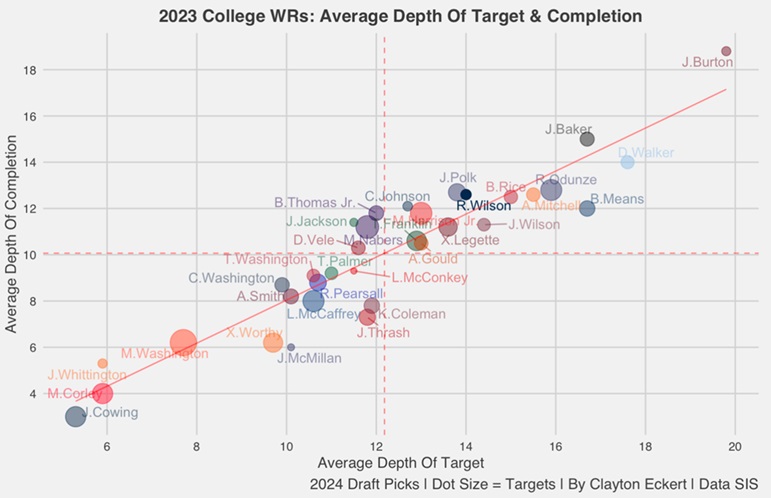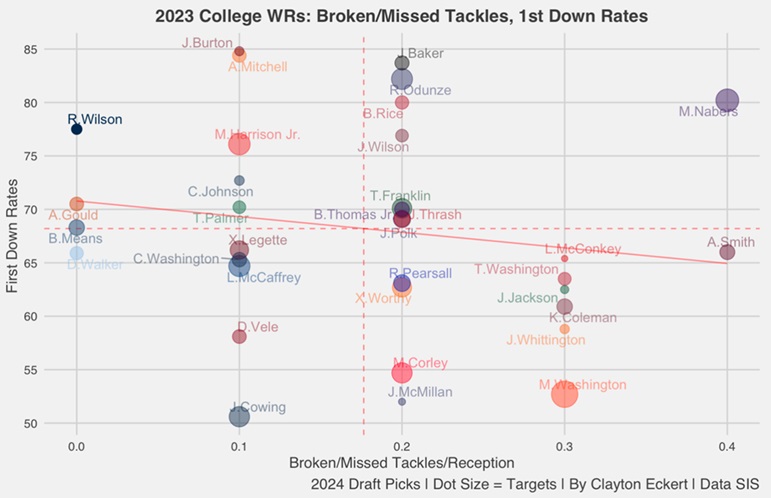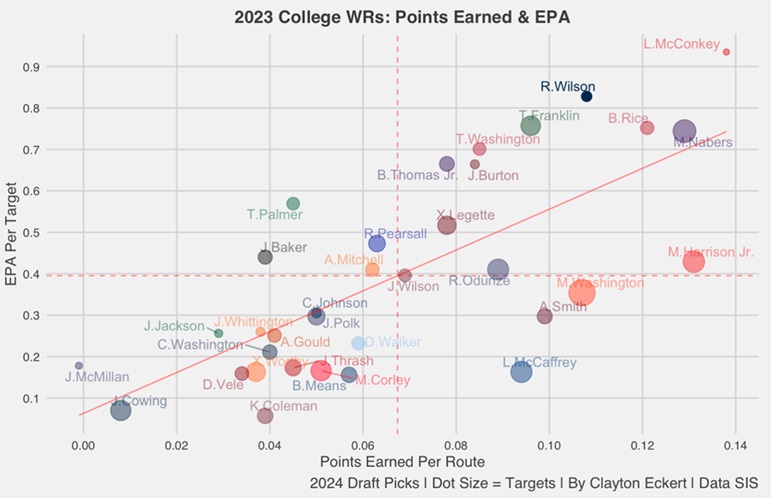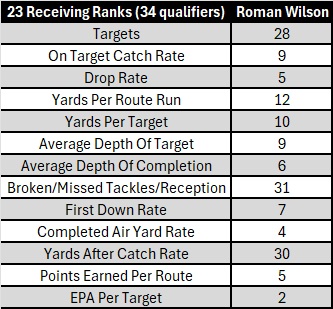Continuing with our post-draft series, I wanted to look at and provide more context for the wide receiver position and Steelers third round pick Roman Wilson using Sports Info Solutions (SIS). I’m focusing on players selected in the 2024 NFL draft, and one player was excluded due to SIS not tracking smaller school players. The goal for today is to see how Wilson stacked up to his peers, and what that could possibly mean as he starts his NFL journey.
Let’s dive in, starting with on target catch percentage (total receptions/number of catchable targets) which highlights the quality of targets and connectivity along with drop percentage (drops/catchable targets) to see who made the most of their expected catch situations:
Wilson lands favorably on the visual, well above the mean among drafted WRs in both data points. Encouragingly, he posted a 94.6 on target catch rate (ninth), along with an even more impressive 2.3 drop rate that ranked fifth-best last season. Being a sure hands catcher is something that Wilson was praised for in his college career and will hopefully be a welcomed skill that continues with Pittsburgh.
Next let’s look at yards per route run (total receiving yards/number of routes run excluding RPO handoffs) and yards per target (receiving yards per pass attempt in which the receiver is targeted, including incompletions) to get an idea of how the wide receivers were utilized:
Being utilized down the field is another aspect that Wilson was above-average in. While he didn’t top the ranks, he tied for 12th with 3.2 yards per route run, and 12.0 yards per target (tenth). Both are healthy numbers and encouraging considering the quality of his catch rates in the previous view. The dot sizes do emphasize lower volume (targets). But as they say, quality over quantity is great to see.
Let’s further examine wide receiver usage with average depth of target (average distance downfield that the targeted throws traveled, excluding spikes and throwaways) and average depth of completion to zero in on opportunities more in the receiver’s control:
Wilson keeps the encouraging theme going, with above-average marks. His 14.0 average depth of target ranked ninth last season, along with a 12.6 average distance of completion (T-sixth). With his experience largely coming as a slot receiver, these numbers surprised me a bit, and could add a potent element that has lacked from that alignment in Pittsburgh. Alignment versatility is likely, and hopefully these findings will translate to the NFL.
Continuing with more important factors, here are the wide receivers first down percentages (percentage of receptions where the receiver achieved a first down) along with broken and missed tackles per reception, a fun and telling data point. The goal here is to see who provided moving the chains plays and which players also showed the ability to make guys miss:
It can’t be all sunshine and rainbows. Wilson had issues in 2023 with forcing broken/missed tackles, tying for the bottom ranking. Part of that is due to being targeted downfield at a high rate, but this will need to improve at the next level given the step up in competition, and likelihood of a higher mixture of short catch opportunities that ideally lead to run long results.
On the other side of the coin, we see Wilson return to a positive light in terms of first down rate. His 77.5 number ranked seventh best among his peers, and considering the other data in the article, can see the vast majority of that has come through air yardage. Of course, moving the chains is vital for any successful offense, and was one of the many factors that Pittsburgh find attractive in his game.
Here are wide receivers completed air yard percentage (CAY% = completed air yards/intended air yards) to gain context of opportunity and connectivity along with a and yards after catch rate (YAC% = yards after catch/total yards) to see what wide receivers created once the ball was in their hands.
This gives us great context of what the players provided for their team, how they were used, along with seeing who fared better in their final season. It also furthers the concern of making defenders miss in 2023 from the previous visual, with Wilson landing very low in the yards after catch department (30th). This is one of the bigger surprises of the study for me, given his athletic profile, which Pittsburgh can hopefully maximize.
The completed air yard rate is rather impressive though, with a solid 65.2 number that ranked fourth in 2023. It will be very interesting to monitor Wilson in these terms. Will his air yardage remain similar with Pittsburgh? Can he provide more yards after the catch than he did his final college season? I can’t wait to find out.
I also wanted to provide a total value view using points earned per route, the total of a player’s EPA responsibility on routes run using the total points system that distributes credit among all players on the field for a given play. Totals are scaled up to map to the average points scored or allowed on a team level, with the player’s snap count determining how much to adjust.
For receivers, this includes accounting for offensive line play, off-target passes, dropped passes, and broken tackles. Values are modulated using a quality-of-competition multiplier based on each opponent’s previous year of performance and EPA per target (the total change in the offense’s expected points that came on passes thrown to the player):
In this more total value approach, we see Wilson provided one of the biggest impacts to his squad last season, part of the 2023 National Championship team to boot. They were stacked with talent to be fair, but gives deserved props to Wilson as well, with the findings in the article adding specific context.
His 0.828 EPA per target was second-best among wide receivers in this year’s draft, while his 0.108 points earned per route ranked fantastic as well (fifth). Important cog for the Wolverines, which is a great fit for Pittsburgh in my opinion, fitting the personality of a Steeler that will hopefully align with another productive season at the next level.
Here is a wrap up table of all the data, with Wilson’s ranks among WRs selected in the 2024 draft, and conclusion:
So, Roman Wilson fared very well in several aspects of the study in his 2023 season at Michigan. We can clearly see strengths, along with room for improvement/areas of struggle.
Top-five rankings, and most encouraging findings included EPA per target (second), completed air yard rate (fourth), drop rate (fifth), and points earned per route (fifth). All are great to see as we anticipate what he could be for the black and gold, along with top ten ranks in average depth of completion (T-sixth), first down rate (seventh), on target catch rate (ninth), average depth of target (ninth), and yards per target (tenth). Wilson also ranked well in yards per route run (T-12th), and I was even more impressed than my already high expectations going into the study.
Much less here, but here are the lower marks from 2023. Wilson wasn’t targeted as much in Michigan’s stacked roster, ranking 28th out of 34 qualifiers, which is very important context to his quality play. Main areas to monitor for hopeful for improvement statistically are his bottom five ranks in yards after catch rate (30th) and broken/missed tackles per reception. The former seems more likely, with his speed and the likelihood that Pittsburgh will want to utilize him in that fashion more than Michigan, but here’s to hoping for both.
I can’t wait to see how Wilson fares, with opportunities there for the taking in Pittsburgh’s WR room behind George Pickens. Yes, there may be an addition that changes the outlook before Week 1, but as we sit here today, I like the chances of Wilson carving out a nice impact role for the Steelers in 2024 (and beyond).
Throughout the rest of the offseason, I will dive deeper into the data as we continue to learn about the newest Pittsburgh Steelers.

